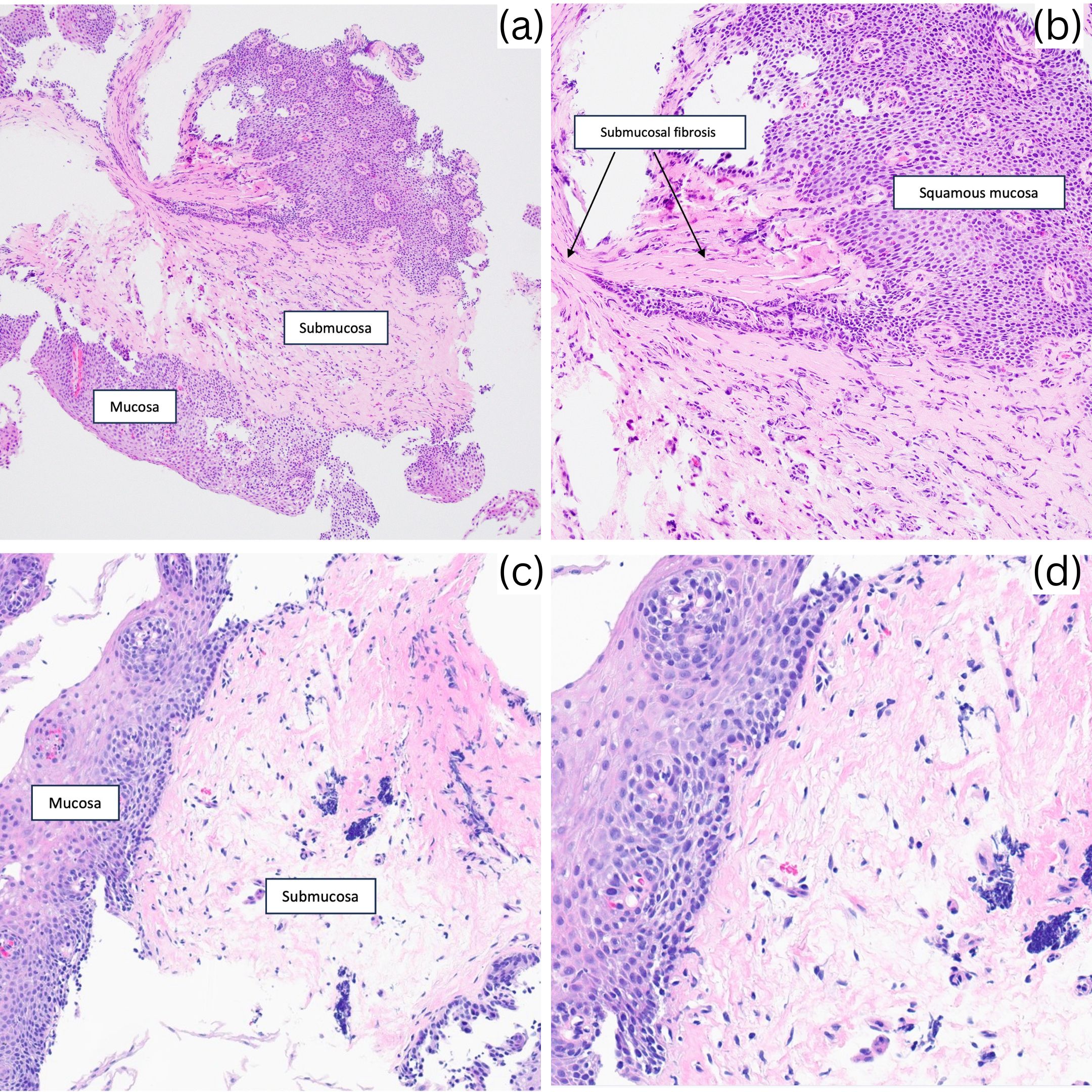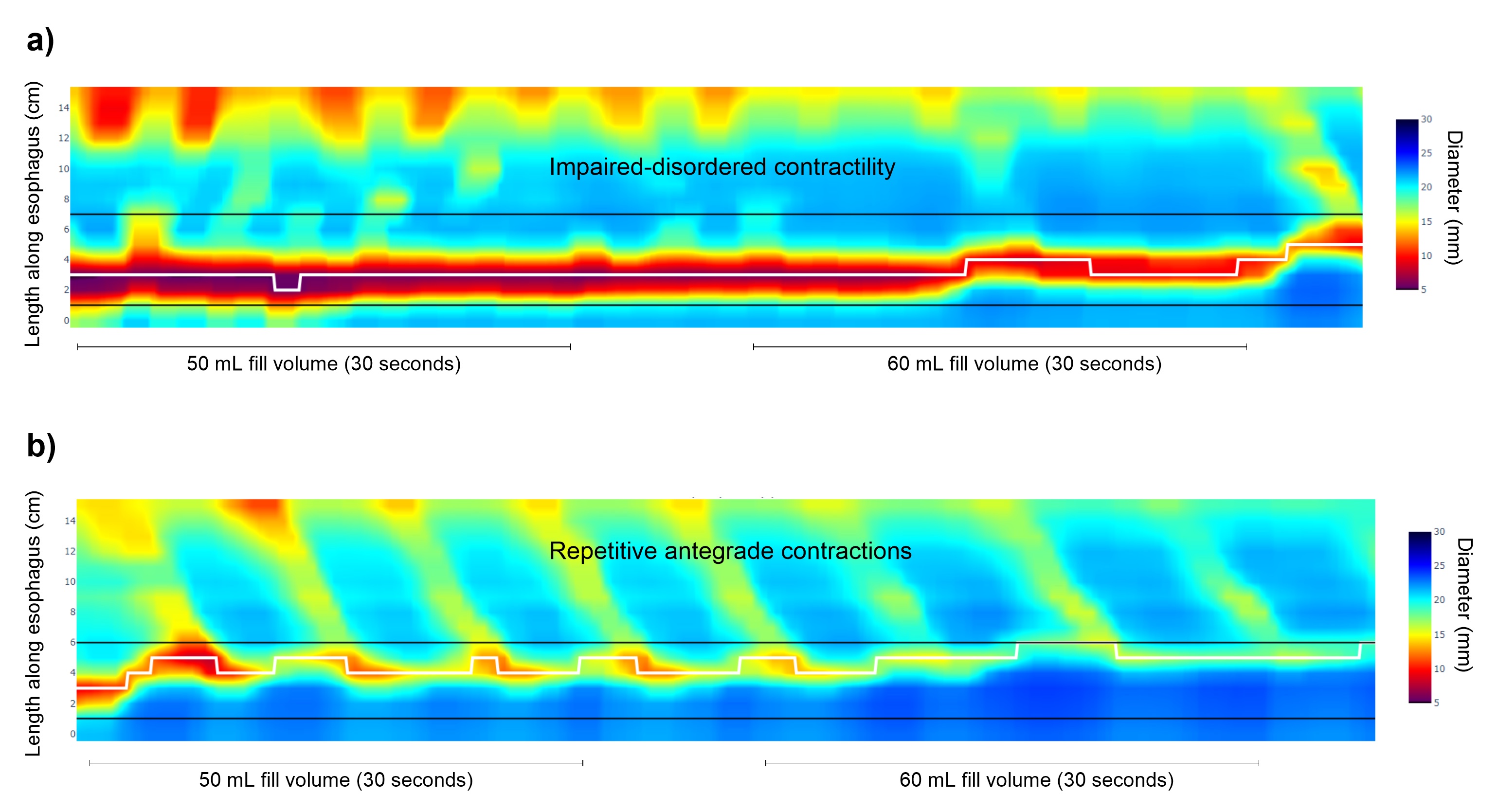Tuesday Poster Session
Category: Esophagus
P4985 - Resolution of Physiologic Changes in Eosinophilic Esophagitis With Dupilumab
Tuesday, October 28, 2025
10:30 AM - 4:00 PM PDT
Location: Exhibit Hall
- KR
Keerthi Reddy, MD
Emory University
Atlanta, GA
Presenting Author(s)
Keerthi Reddy, MD1, Maryam Aghighi, MD1, Anand Jain, MD2
1Emory University, Atlanta, GA; 2Emory University School of Medicine, Atlanta, GA
Introduction: Eosinophilic esophagitis (EoE) is type of esophagitis caused by inflammation mediated by eosinophils. Clinical features include dysphagia and food bolus impaction, but the disease is also associated with atopy. Diagnosis requires greater than or equal to 15 eosinophils per high power field (HPF). Treatment includes high dose proton-pump inhibitor (PPI) therapy, topical steroids, or dupilumab in refractory or severe cases.
Case Description/
Methods: We present a case of a 36-year-old female with physiological dysfunction due to subepithelial EoE which was resolved with biologic therapy with dupilumab. The patient’s EoE was diagnosed 2 years prior to evaluation at our center, with primary symptoms of dysphagia, odynophagia, and epigastric pain. Our initial esophagogastroduodenoscopy (EGD) on twice daily PPI therapy showed an Eosinophilic Esophagitis Endoscopic Reference Score (EREFS) score of E1R2E0F1S1 and histology showed up to 30 eosinophils/HPF and submucosal fibrosis. Twice daily swallowed budesonide slurry (1 mg) therapy was initiated. EGD 3 months later showed improved endoscopic findings (E1R0E0F0S0), however functional lumen imaging probe (FLIP) study at the time showed an impaired-disordered contractile response, an abnormal distensibility plateau of 12 mm at the esophagogastric junction (EGJ). Histology showed resolved epithelial eosinophilia (0/HPF), however showed no improvement in submucosal fibrosis. Given the persistent submucosal fibrosis and lack of symptomatic improvement, weekly subcutaneous dupilumab 300 mg was initiated while stopping PPI therapy and topical corticosteroids. EGD with FLIP performed 3 months later on dupilumab monotherapy showed continued endoscopic remission (E0R0E0F0S0) and normal contractile response on FLIP with distensibility plateaus in the normal range at >18mm. Histology at this time showed no eosinophils and resolved submucosal fibrosis. Notably, dysphagia and odynophagia were resolved as well.
Discussion: Subepithelial EoE may cause changes in esophageal physiology by affecting function of esophageal smooth muscle. This can be measured during endoscopy with FLIP. Biologic therapy, such as with dupilumab, might uniquely treat subepithelial complications of EoE.

Figure: Figure 1: Proximal esophagus prior to initiation of dupilumab with submucosal fibrosis and 30 eosinophils per high power field (1a, 1b) and after 7 months of dupilumab with little to no submucosal fibrosis and no eosinophils (1c, 1d)
(a) Mucosa and submucosa prior to dupilumab (H&E, 100X)
(b) Squamous mucosa and submucosal fibrosis prior to dupilumab (H&E, 200X)
(c) Mucosa and submucosa after dupilumab (H&E, 100X)
(d) No submucosal fibrosis and no eosinophils after dupilumab (H&E, 200X)

Figure: Figure 2: Functional lumen imaging probe (FLIP) topography before (panel a) and after (panel b) therapy with dupilumab is shown. FLIP shows impaired-disordered contractile response prior to dupilumab therapy which normalizes to a repetitive antegrade contraction pattern afterwards.
Disclosures:
Keerthi Reddy indicated no relevant financial relationships.
Maryam Aghighi indicated no relevant financial relationships.
Anand Jain indicated no relevant financial relationships.
Keerthi Reddy, MD1, Maryam Aghighi, MD1, Anand Jain, MD2. P4985 - Resolution of Physiologic Changes in Eosinophilic Esophagitis With Dupilumab, ACG 2025 Annual Scientific Meeting Abstracts. Phoenix, AZ: American College of Gastroenterology.
1Emory University, Atlanta, GA; 2Emory University School of Medicine, Atlanta, GA
Introduction: Eosinophilic esophagitis (EoE) is type of esophagitis caused by inflammation mediated by eosinophils. Clinical features include dysphagia and food bolus impaction, but the disease is also associated with atopy. Diagnosis requires greater than or equal to 15 eosinophils per high power field (HPF). Treatment includes high dose proton-pump inhibitor (PPI) therapy, topical steroids, or dupilumab in refractory or severe cases.
Case Description/
Methods: We present a case of a 36-year-old female with physiological dysfunction due to subepithelial EoE which was resolved with biologic therapy with dupilumab. The patient’s EoE was diagnosed 2 years prior to evaluation at our center, with primary symptoms of dysphagia, odynophagia, and epigastric pain. Our initial esophagogastroduodenoscopy (EGD) on twice daily PPI therapy showed an Eosinophilic Esophagitis Endoscopic Reference Score (EREFS) score of E1R2E0F1S1 and histology showed up to 30 eosinophils/HPF and submucosal fibrosis. Twice daily swallowed budesonide slurry (1 mg) therapy was initiated. EGD 3 months later showed improved endoscopic findings (E1R0E0F0S0), however functional lumen imaging probe (FLIP) study at the time showed an impaired-disordered contractile response, an abnormal distensibility plateau of 12 mm at the esophagogastric junction (EGJ). Histology showed resolved epithelial eosinophilia (0/HPF), however showed no improvement in submucosal fibrosis. Given the persistent submucosal fibrosis and lack of symptomatic improvement, weekly subcutaneous dupilumab 300 mg was initiated while stopping PPI therapy and topical corticosteroids. EGD with FLIP performed 3 months later on dupilumab monotherapy showed continued endoscopic remission (E0R0E0F0S0) and normal contractile response on FLIP with distensibility plateaus in the normal range at >18mm. Histology at this time showed no eosinophils and resolved submucosal fibrosis. Notably, dysphagia and odynophagia were resolved as well.
Discussion: Subepithelial EoE may cause changes in esophageal physiology by affecting function of esophageal smooth muscle. This can be measured during endoscopy with FLIP. Biologic therapy, such as with dupilumab, might uniquely treat subepithelial complications of EoE.

Figure: Figure 1: Proximal esophagus prior to initiation of dupilumab with submucosal fibrosis and 30 eosinophils per high power field (1a, 1b) and after 7 months of dupilumab with little to no submucosal fibrosis and no eosinophils (1c, 1d)
(a) Mucosa and submucosa prior to dupilumab (H&E, 100X)
(b) Squamous mucosa and submucosal fibrosis prior to dupilumab (H&E, 200X)
(c) Mucosa and submucosa after dupilumab (H&E, 100X)
(d) No submucosal fibrosis and no eosinophils after dupilumab (H&E, 200X)

Figure: Figure 2: Functional lumen imaging probe (FLIP) topography before (panel a) and after (panel b) therapy with dupilumab is shown. FLIP shows impaired-disordered contractile response prior to dupilumab therapy which normalizes to a repetitive antegrade contraction pattern afterwards.
Disclosures:
Keerthi Reddy indicated no relevant financial relationships.
Maryam Aghighi indicated no relevant financial relationships.
Anand Jain indicated no relevant financial relationships.
Keerthi Reddy, MD1, Maryam Aghighi, MD1, Anand Jain, MD2. P4985 - Resolution of Physiologic Changes in Eosinophilic Esophagitis With Dupilumab, ACG 2025 Annual Scientific Meeting Abstracts. Phoenix, AZ: American College of Gastroenterology.
